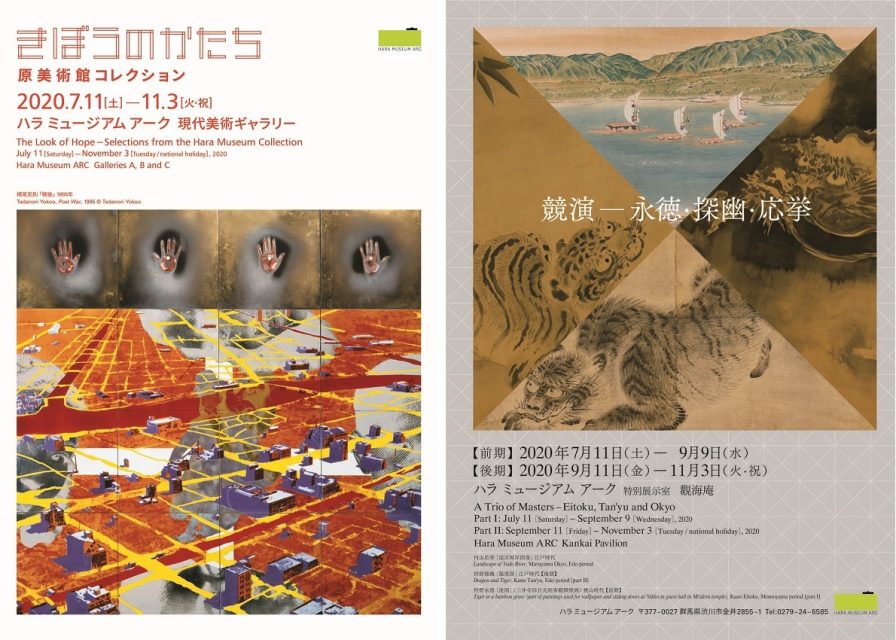
“The Look of Hope-Selections from the Hara Museum Collection”
July 11 (Saturday) – November 3 (Tuesday/national holiday), 2020
Venue: Galleries A, B and C (Contemporary Art) at Hara Museum ARC
Since the beginning, we humans have had the custom of saying or sharing something in order to mutually heal, energize, bolster or encourage one another. Faced as we are with an invisible enemy that is a virus, the time may have come for us to think hard about and choose what gives us the hope and joy we need to live. Against the backdrop of a scorched landscape in the aftermath of war, Tadanori Yokoo superimposed the silhouette of a diva to express the light of reconstruction. In this exhibition, this and other works totalling 40 by living artists are gathered together under the keyword of “hope.” Also on view will be 10 works by Christo who passed away this May.
Featured Artists
Christo, Francesco Clemente, Masahito Katayama, Kazuo Kenmochi, Kengo Kito, Kae Masuda, Yasumasa Morimura, Nobuhira Narumi, Minoru Ohira, Shinro Ohtake, Sigmar Polke, Hiroshi Sugimoto, Yuriko Takagi, Tadanori Yokoo and others
Semi-permanent Exhibits
Large-scale installations by Yayoi Kusama and Tabaimo
Number of exhibited works
approx. 50
“A Trio of Masters-Eitoku, Tan’yu and Okyo”
Part I: July 11 (Saturday) – September 9 (Wednesday), 2020
Part II: September 11 (Friday) – November 3 (Tuesday/national holiday), 2020
Kankai Pavilion, Hara Museum ARC
This exhibition looks mainly at the work of three painters who were active during the period from the Momoyama era to the Edo era. Kano Eitoku (1543-90) is credited with many of the magnificent paintings that adorned fusuma sliding doors and other large-scale partitions during the Momoyama era. Kano Tan’yu (1602-74), Eitoku’s grandson, continued the Kano tradition as a painter in the service of the Tokugawa Shogunate. Ink paintings by these two masters are contrasted with the work of Maruyama Okyo (1733-95), the progenitor of a school of naturalistic painting in Japan which emphasized the real-life sketching of landscapes and people. On exhibit will be Okyo’s vibrantly colored scroll painting Landscape of Yodo River as well as the original sketch on which it was based.
Featured Works
[Part I & II] Traditional Art: Landscape of Yodo River, Maruyama Okyo, hand scroll Edo period /Sketch of Yodo River, Maruyama Okyo, hand scroll, Edo period
[Part I] Tiger in a bamboo grove, Kano Eitoku, four hanging scrolls, Momoyama period / Li Bai, viewing waterfall, Kano Tan’yu, hanging scroll, Edo period / Sumo match, part of six-fold screens, Edo period / Case of a sword decorated with flower scroll design, black lacquer with maki-e, Edo period and others
[Part II] Tiger in a bamboo grove, Kano Eitoku, hanging scroll, Momoyama period / Dragon and tiger, Kano Tan’yu, pair of hanging scrolls, Edo period / Field with the moon, the subject called “Musashino” in Japanese, eight-fold screens, Edo period / Tier of boxes decorated with design of squirrels in vine scrolls, Maki-e on lacquer, Edo – Meiji period and others
Contemporary Art: Anish Kapoor / Tokihiro Sato / Hitomi Uchikura and others
Hara Museum ARC
Address: Hara Museum ARC 2855-1 Kanai, Shibukawa-shi, Gunma 377-0027
Tel: 0279-24-6585 Official website: https://www.haramuseum.or.jp Twitter: @HaraMuseumARC
Hours: 9:30 am – 4:30 pm (last entry at 4:00 pm)
Closed: Thursdays (except July 23 and during the month of August)
*The museum may be subject to temporary closure in the future, depending on the situation with the novel coronavirus. The updated information will be posted on the museum website.
Admission: General 1,100 yen, Students 700 yen (high school and university) or 500 yen (elementary and junior high), Free for Hara Museum members /Combination ticket for Hara Museum ARC and Ikaho Green Bokujo: General 1,800 yen, Students 1,500 yen (high school and university) or 1,400 yen (junior high), 800 yen (elelmentary), half price for those over 70
Directions: By train: Take the Joetsu Shinkansen to Takasaki, change to the Joetsu Line, and disembark at Shibukawa. From Shibukawa, ARC is 10 minutes away by taxi or 15 minutes by bus (take the Ikaho Onsen bus to “Green Bokujo Mae”). By car: 8 kilometers (about 15 minutes) from the Kan-etsu Expressway Shibukawa Ikado Interchange (in the direction of Ikaho Onsen). By Express Bus: JR Bus Kanto from Tokyo Station Yaesu South Exit/Shinjuku Express Bus Terminal to Shibukawa/Ikaho Onsen/Kusatsu Onsen http://time.jrbuskanto.co.jp.e.wn.hp.transer.com/bk03010.html
